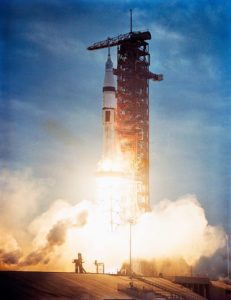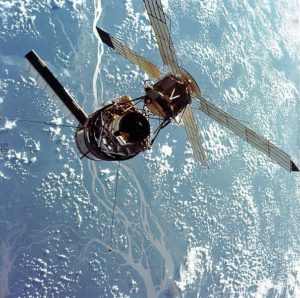On July 28th, 1973, a Saturn 1B rocket launched from Launch Complex 39-B at Kennedy Space Center carrying astronauts Alan Bean, Owen Garriott, and Jack Lousma into orbit for the Skylab 3 mission. This mission was, as you would expect, a direct follow up to the 28 day Skylab 2 mission. Skylab 3 would remain at the station for a planned 58 days, conducting both biological and astronomical studies.
 Unlike the delayed and rather drastically changed Skylab 2 mission, Skylab 3 was a far more “typical” mission for what the Orbital Workshop was designed for. Repairs to Skylab made during the SL-2 mission had held, and the station was in good working order for the crew when they arrived.
Unlike the delayed and rather drastically changed Skylab 2 mission, Skylab 3 was a far more “typical” mission for what the Orbital Workshop was designed for. Repairs to Skylab made during the SL-2 mission had held, and the station was in good working order for the crew when they arrived.
The flight to the station wasn’t without its own problem, however – during the approach to the space station, a leak developed in one of the four thruster quads of the Apollo Service Module. These smaller thruster arrangements provided maneuvering capabilities for the Apollo spacecraft and were critical not only to maneuver to and dock with Skylab, but also to orient the spacecraft properly for the return to Earth.
The crew was able to dock with Skylab on the 1st day in orbit, but 6 days later a second quad had begun to develop a leak. A rescue mission had been planned for as a possibility, and a specially modified Apollo spacecraft and Saturn 1B launch vehicle were prepared at LC-39B for the possibility of launching in an effort to rescue the true should they become stranded on the station. This, thankfully, wasn’t to be the case, as it was determined the Skylab 3 CSM could maneuver safely with 2 of the 4 thruster quads disabled.
On August 6th the first of 3 Extra-Vehicular Activities was conducted which included the installation of the “twin-pole” sunshade that was brought up to the station on Skylab 2. This would provide an additional layer of protection, over the Skylab 2 “parasol” shade, from the suns heat to the Orbital Workshop.
Scientific research on the station was diverse – both astronomical measurements, solar observations, Earth research, studies on how humans handle 2 months in orbit, and even (a personal favorite) the study of how spiders would produce webs in micro gravity. I’m quite fond of the two spiders brought up, Arabella and Anita.
Some other experiments didn’t fare as well, but on a whole the mission was an incredible success, generally operating ahead of schedule, by the end of things, providing us more information than originally planned, which is obviously a great thing giving the, sadly, limited nature of the Skylab program.
This is a mission I honestly need to look into more. While I know generally what Skylab missions were like, I don’t know too much in detail about this particular mission – it’s kind of the “odd man out” for Skylab. I’ll see what videos on the flight I can find, and share soon.
For now, however, the launch of Skylab 3. As a side note, you have to love how the ignition of the 8 H-1 engines looks for Saturn 1B’s launching from the “milk stool” – nothing else quite like it.
https://en.wikipedia.org/wiki/Skylab_3
More to come, as always.


